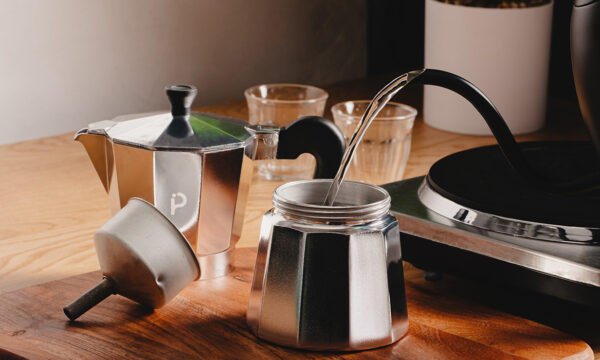
How to Use a Moka Pot: Your Guide to Making Perfect Italian-Style Coffee

Written by Jordan
Reading time 5 minDo you know the difference between the French press and moka pot? We’ll explain what’s special about each of these coffee makers, so you can choose the one that’s right for your needs.
Test directly on video
Our Youtube channelHistory of the moka pot, also known as the Italian coffee maker or the espresso pot
The moka pot was created and invented in Italy in 1933 by Alfonso Bialetti.
The Italian coffee maker was a great success from the outset. This success lasted until the Second World War. After the war, Alfonso Bialetti’s son took over the company and made some changes to distinguish their own goods from counterfeits.
Mainly used in Europe, this coffee maker revolutionized homemade coffee and is now a must have in any kitchen.
How does the Moka pot work?
The Italian coffee maker consists of two parts, which are separated by a filter. Ground coffee is placed inside the filter basket while the lower pot is filled with water. As the pot is heated, the water in the base boils and creates steam which passes through the filter and mixes with the ground coffee. The coffee then flows down the outside of the chimney and into the upper pot.
It takes just a few minutes to prepare an espresso. This coffee maker can also be used as a coffee pot.
Most Moka pots are made from either aluminium or stainless steel. Aluminium is lighter and less expensive but stainless-steel coffee makers work on all types of stoves. Aluminium Moka pots are not compatible with induction cooktops.
The French press first appeared in Paris in 1852.
But it was officially created by Frenchman Marcel-Pierre Paquet who, a few years later in 1923, registered the patent. It is often wrongly attributed to the Italian Attilio Calimani whose patent dates from a later date (1929). He was, however, the first to market it.
The French press coffee maker has changed over the years. In 1959, Faliero Bondanini launched the first production of the coffee press in a factory in France, hence the name ‘French Press’.
This coffee maker is made up of a narrow cylindrical pitcher or beaker that is usually made of plastic or glass. It is fitted with a lid and a plastic or metal filter that fits snugly into the cylinder, and features a mesh screen. A stylish object, it also comprises a stainless steel frame, glass carafe and black lid equipped with a plunger.
Very recognisable, it is both simple and efficient. Over time, many different models and variations have appeared, some being more stylish or offering a particular quality.
Take the New Spezia French press, for example. It has a borosilicate glass handle and jug. This material is heat-resistant up to 300 °C and is not affected by temperature shocks.
Some French press makers even feature a double-wall or double-filter system.
Regardless of special features, all French press coffee machines work the same way.
Both inexpensive, these two coffee makers have similar advantages. First they are both easy to use and affordable. If you don’t mind taking your time making your espresso, these two coffee makers are perfect. It will take 5 minutes for your delicious coffee to be ready to drink. Which one is better depends on what type of coffee you prefer.
If you want to wake up with a strong and thick shot of espresso, the Moka pot is perfect.
If you’re looking for smoother, richer flavours and aromas, the French press maker is ideal. Its brewing process allows this coffee maker to release all the aromas and oils of your coffee. The result tastes like a good americano.
These two coffee makers have similar pros and cons. Notably their price and brew time. If you like to take your time in the morning, at lunchtime or in the evening, these coffee makers may be just what you need for a delicious cup of coffee. Now all that’s left is to pick!
Discover all of our articles